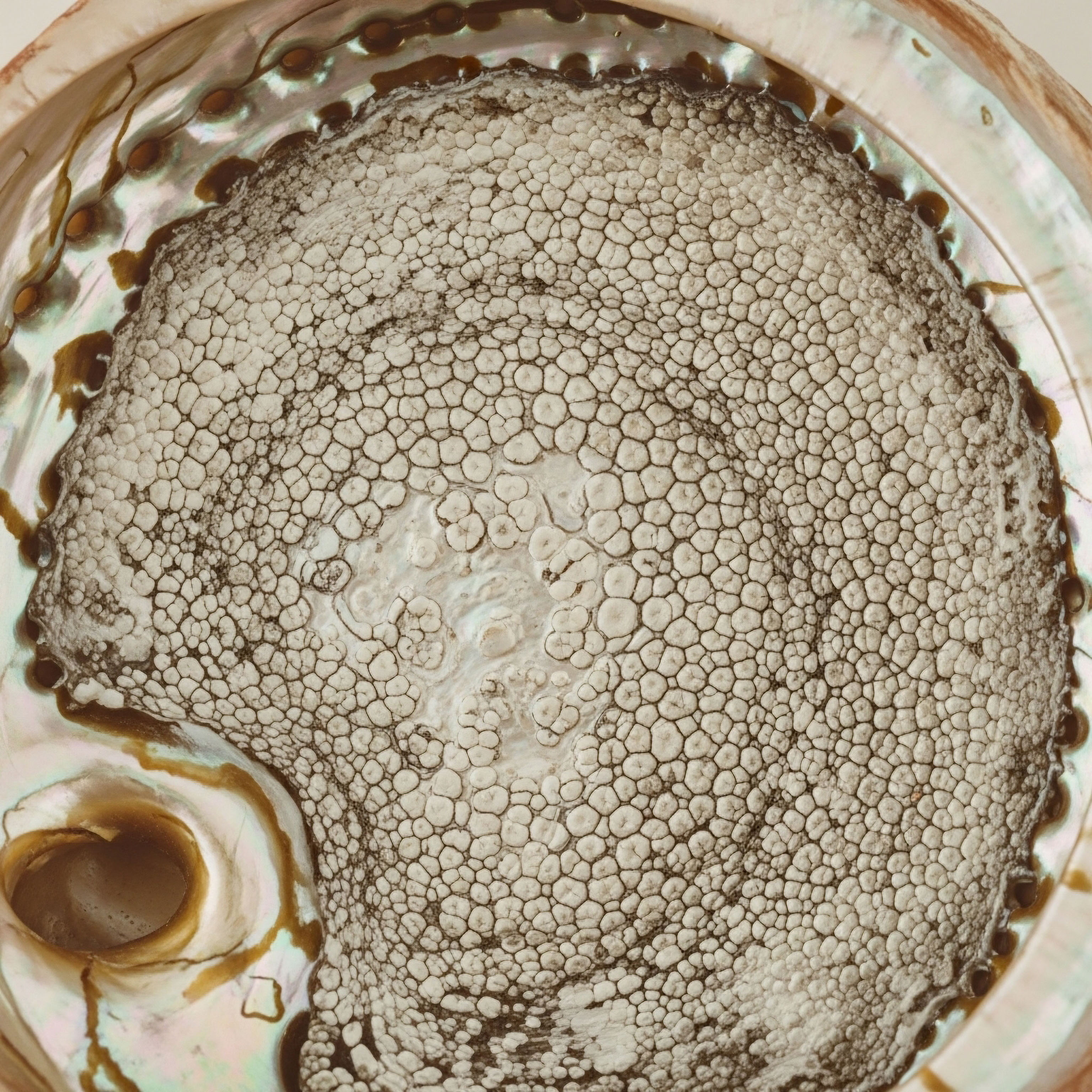

Fundamentals
You may feel a sense of dissonance when you hear the word “androgen” in a conversation about female health. The term, most commonly associated with testosterone, is often framed exclusively within male biology. This perspective, however, overlooks a fundamental truth of our shared physiology.
Your body is a finely tuned orchestra of chemical messengers, and androgens are essential players for everyone. Understanding their role, specifically within the sensitive environment of mammary tissue, is a powerful step toward comprehending your own unique biological blueprint and achieving a state of sustained wellness.
At the very heart of this conversation are androgen receptors, or AR. Think of these receptors as sophisticated docking stations located on the surface of and inside your cells. Hormones, like androgens, circulate through your system carrying specific messages. For a message to be received and acted upon, the hormone must find and bind to its corresponding receptor.
When an androgen like testosterone docks with an androgen receptor in a mammary cell, it initiates a cascade of instructions that are vital for tissue stability and health.

The Cellular Communication Network
Your body operates on a constant flow of information. Hormones are the letters, and receptors are the mailboxes. Mammary tissue is particularly dense with these mailboxes, making it highly responsive to the body’s hormonal state. It has receptors not only for androgens but also for estrogens, the primary female sex hormones. The balance between the signals sent by these two distinct hormonal families is what dictates the cellular environment of the breast.
Estrogen is a powerful growth promoter. Its primary message to mammary cells is to proliferate and grow, a necessary function for the development of the mammary gland. Androgens, acting through their receptors, provide a crucial counter-signal. They function as a biological brake, instructing cells to slow down proliferation and promote differentiation, which is the process of a cell becoming specialized. This interaction creates a state of dynamic equilibrium, essential for maintaining healthy, stable tissue architecture.
Androgen receptors provide a critical counterbalance to estrogen’s growth signals within mammary tissue.

Why Is This Balance so Important?
A system with an accelerator needs a reliable brake. In mammary tissue, unopposed estrogenic signaling can lead to excessive cellular growth, which underlies many health concerns. The presence and proper function of androgen receptors ensure that growth signals are appropriately checked and balanced.
This protective role is a foundational aspect of mammary tissue health throughout a woman’s life. When we consider hormonal wellness, we are truly talking about supporting this intricate system of checks and balances, ensuring every signal is sent, received, and acted upon in the correct measure. This understanding moves us from a simplistic view of hormones to a more complete appreciation of our body’s complex and elegant regulatory design.


Intermediate
To truly appreciate the influence of androgen receptors on mammary tissue, we must examine the precise mechanisms of their interaction with other hormonal pathways. The relationship between androgen receptors (AR) and estrogen receptors (ER), particularly the most common form, estrogen receptor alpha (ERα), is a central feature of this biological system.
Their interplay occurs at the molecular level, directly within the cell’s nucleus, where genetic instructions are read and executed. This dynamic is a beautiful example of cellular regulation, where opposing inputs are integrated to produce a stable, functional outcome.

A Tale of Two Receptors
When estrogen binds to its receptor (ERα), the resulting complex travels to the cell’s DNA. There, it attaches to specific sequences known as Estrogen Response Elements (EREs). This binding event initiates the transcription of genes that typically promote cell proliferation. It is the “go” signal for cell division. The androgen receptor introduces a layer of sophisticated regulation to this process. When activated by an androgen, the AR can interfere with ERα’s activity in several ways.
- Direct Competition ∞ The activated AR can bind to the same EREs that ERα targets. By occupying this genetic real estate, AR physically blocks ERα from initiating its growth-promoting gene expression program.
- Receptor Downregulation ∞ Sustained androgen signaling has been shown to decrease the total number of estrogen receptors available in a cell. Fewer receptors mean the tissue becomes less sensitive to estrogen’s proliferative signals, effectively turning down the volume on its growth messages.
- Co-regulator Sequestration ∞ Both AR and ERα rely on a supporting cast of proteins called co-regulators to carry out their functions. AR can effectively recruit these essential proteins, making them unavailable to assist ERα, thereby weakening its transcriptional power.

What Determines the Androgen Receptor’s Role?
The function of the androgen receptor is profoundly context-dependent. Its effect on a cell is determined by the cell’s own internal landscape, most notably the presence or absence of estrogen receptors. This distinction is critical in understanding both normal physiology and the progression of certain breast conditions. The same receptor can perform different, even opposing, functions based on the cellular environment it inhabits.
The androgen receptor’s function is conditional, shifting from a growth inhibitor to a potential growth driver depending on the cell’s estrogen receptor status.
This dual potential is a key concept in modern endocrinology and has significant implications for developing personalized health strategies. Evaluating the specific hormonal receptor profile of tissue provides a much clearer picture of its internal signaling environment, allowing for more targeted and effective support.
| Cellular Context | Primary AR Function | Underlying Mechanism |
|---|---|---|
| ER-Positive Cells | Growth Inhibitory / Protective | AR signaling actively opposes and dampens the proliferative effects of ER signaling through molecular crosstalk. |
| ER-Negative Cells (Certain Subtypes) | Potentially Growth-Promoting | In the absence of ER, AR signaling can become the dominant pathway, sometimes driving cell growth and proliferation. |


Academic
The clinical and scientific investigation into the androgen receptor’s role in mammary biology has revealed a complex and highly nuanced system. Moving beyond its general anti-estrogenic functions, research now focuses on its specific contributions to different subtypes of breast cancer, particularly in triple-negative breast cancer (TNBC).
TNBC is defined by the absence of estrogen receptors, progesterone receptors, and overexpression of human epidermal growth factor receptor 2 (HER2). In this cellular environment, the androgen receptor emerges as a primary signaling molecule and a viable therapeutic target.

AR Signaling in Triple-Negative Breast Cancer
Approximately 10-40% of triple-negative breast cancers express the androgen receptor. In this context, a subset of these tumors, known as molecular apocrine tumors, can become dependent on AR signaling for their growth and survival. The term “apocrine” refers to a specific cell type in the breast, and these tumors exhibit a gene expression signature that is similar to cells regulated by androgens.
In the absence of ER-driven growth signals, these cells can effectively hijack the AR pathway to fuel their proliferation. The mechanisms are intricate, involving the activation of downstream growth factor pathways that would normally be kept in check by a balanced hormonal environment.

How Can Androgen Receptors Be a Therapeutic Target?
The dependency of AR-positive TNBC on androgen signaling presents a unique therapeutic opportunity. Clinical research is actively exploring the use of AR antagonists, drugs that block the androgen receptor, in this specific patient population. These therapies, already established in the treatment of prostate cancer, function by preventing androgens from docking with the AR, thereby silencing its growth-promoting instructions.
This approach is a prime example of targeted therapy, where treatment is tailored to the specific molecular characteristics of the tumor. Understanding the AR status of a tumor becomes a critical piece of diagnostic information, guiding a more precise and potentially more effective clinical strategy.
In the specific context of ER-negative breast cancer, androgen receptor signaling can shift from a suppressive to a driving force of cellular proliferation.
This line of investigation underscores a critical principle of systems biology ∞ a single component’s function can only be understood in the context of the entire system. The health of mammary tissue is not governed by any single hormone but by the integrated output of multiple, interconnected signaling axes, including the Hypothalamic-Pituitary-Gonadal (HPG) axis which regulates sex hormone production.
Disruptions in this systemic balance can alter the local hormonal milieu of the breast, influencing receptor activity and long-term tissue stability.
| Breast Cancer Subtype | Approximate AR Expression Prevalence | Primary Clinical Significance |
|---|---|---|
| Luminal A (ER+/PR+/HER2-) | 70-90% | AR expression is often associated with a better prognosis, likely due to its opposition to ER-driven growth. |
| Luminal B (ER+/HER2+ or high proliferation) | ~70% | The role is complex, with interactions between AR, ER, and HER2 pathways influencing cell behavior. |
| HER2-Enriched (ER-/PR-/HER2+) | 30-50% | Crosstalk between AR and HER2 signaling pathways is an area of active investigation for new therapeutic strategies. |
| Triple-Negative (ER-/PR-/HER2-) | 10-40% | In a subset of these tumors (molecular apocrine), AR can be a primary growth driver and a key therapeutic target. |
The prevalence of AR across all subtypes makes it the most commonly expressed steroid hormone receptor in breast cancer. This fact alone necessitates a deeper, more integrated understanding of its function. Future therapeutic protocols will likely involve a more sophisticated approach, modulating the activity of multiple receptor pathways simultaneously to restore a state of cellular balance and control.

References
- Buchanan, G. et al. “Minireview ∞ The Androgen Receptor in Breast Tissues ∞ Growth Inhibitor, Tumor Suppressor, Oncogene?” Journal of Steroid Biochemistry and Molecular Biology, vol. 122, no. 4, 2010, pp. 147-55.
- Bodnar, et al. “Androgen Receptors in Human Breast Cancer and Female Canine Mammary Tumors.” International Journal of Molecular Sciences, vol. 24, no. 6, 2023, p. 5463.
- Bronte, G. et al. “Androgen receptor in breast cancer ∞ The ‘5W’ questions.” Frontiers in Endocrinology, vol. 13, 2022, p. 1021835.
- Collins, L.C. and S.J. Schnitt. “The androgen receptor in breast cancer ∞ a novel therapeutic target.” The American Journal of Pathology, vol. 172, no. 1, 2008, pp. 3-8.
- Gucalp, A. and T.A. Traina. “Targeting the androgen receptor in triple-negative breast cancer.” Current Problems in Cancer, vol. 40, no. 4, 2016, pp. 141-50.
- Peters, A.A. et al. “The androgen receptor ∞ a therapeutic target in breast cancer.” Expert Opinion on Therapeutic Targets, vol. 13, no. 11, 2009, pp. 1293-305.
- Hickey, T.E. et al. “The androgen receptor in breast cancer ∞ a key collaborator in estrogen receptor-positive tumors.” Endocrine-Related Cancer, vol. 28, no. 4, 2021, T1-T19.

Reflection

Calibrating Your Internal Systems
The information presented here offers a view into the intricate and elegant biology that governs your cellular health. This knowledge is more than academic. It is the foundation upon which a truly personalized understanding of your body is built. Seeing your physiology as an interconnected system of signals and receptors opens a new perspective.
Each symptom, each lab result, and each feeling is a piece of data from this complex network. Your personal health journey is about learning to read this data, to understand the unique balance of your internal environment, and to make informed choices that support its optimal function. The goal is a state of vitality and resilience, achieved by working with your body’s innate intelligence.

Glossary

testosterone

mammary tissue

androgen receptors

androgen receptor

mammary tissue health

estrogen receptors

triple-negative breast cancer

breast cancer

molecular apocrine




